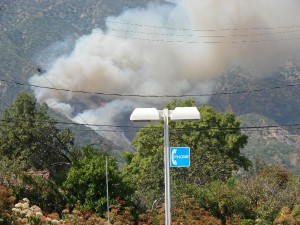
Taken about 3:15pm, shortly after the fire started, from AM/PM at Santa Anita and Foothill. Copyright 2008, Bill Coburn, click to enlarge
Posted 4/25/13 – Santa Anita Fire: Facts and Background
Saturday, April 26th, 2008, started out like many other spring days in Sierra Madre. Blue skies, a high of 80 degrees expected, and multiple community activities scheduled. The City was going to hold dedication ceremonies for its first new park in thirty years, Goldberg Park in honor of long-time residents Milton and Harriet Goldberg that morning. Later in the day, at Memorial Park, the now defunct Community Arts Commission was going to hold a Jazz Festival featuring live music. Little did folks who planned to attend both events realize as they left the first one, that the second one would never take place.
The Jazz Festival was cancelled because a fire, dubbed the Santa Anita Fire by state and federal fire officials, broke out at about 3pm in the mountains above Sierra Madre. The fire burned for several days, ultimately burning 584 acres at the time of its containment on May 1st. Two hundred thirty eight acres were in the Angeles National Forest, and three hundred forty six acres were within the corporate boundaries of Sierra Madre. Five minor injuries were reported, and at one point 1,055 firefighters were assigned to the fire. Just after midnight on Sunday morning the 28th, the City Council, under the leadership of Mayor Kurt Zimmerman, had an emergency meeting to declare the City to be in a state of emergency, freeing up resources from outside agencies to assist in fighting the fire.
Two Red Cross shelters were set up. Approximately 1000 people were evacuated from Oak Crest Drive across Carter Avenue to East Mira Monte Avenue, continuing down
Mountain Trail Avenue, across Grandview Avenue to Santa Anita Avenue. A wedding party of 45 people and four pets were helicoptered out from Sturtevant Camp, it took five helicopter trips to move them all.
The people of Sierra Madre banded together as a community to help each other and the emergency personnel fighting the fire, controlling traffic, and keeping out looters (there was a false report that houses in the evacuation area were robbed).
In the end, only one small non-residential structure was destroyed, and the people of Sierra Madre had a new sense of community and appreciation for one another and emergency personnel. To view our coverage of the 2008 Sierra Madre fire (officially named the Santa Anita Fire by incident command personnel), click here.
Sierra Madre Fire Department
In recognition of their efforts, the entire Sierra Madre Fire Department was named Grand Marshal of the 2008 4th of July Parade.
I asked Fire Chief Steve Heydorff to assist with this article, and he was kind enough to do so.
SMNN: How has the Fire Department improved its preparedness for the next fire?
Chief Heydorff: Our Fire Department has changed a lot in the last five years; the most significant change being that we now have 24-hour staffing of both the RA and fire engine. Our 24-hour manning at the station has also improved our response time to the scene of any fire.
The addition of full-time paid Captains is just one aspect in the Fire Department’s increase in preparedness. The other aspects are more training hours for both firefighters and officers; and we have received a new fire engine since the Santa Anita Fire. Communication is always the number one complaint on any after action review of a fire; community donations, like the radios from Rotary, help at a time when we were very low on new digital radios. (Editor’s Note: click here to view our coverage of the radio donation).
Thanks to increased training and the change in staffing models we have improved from an ISO rating of class IV to a class III. However, the City still has the same levels of reciprocity as it did five years ago – mutual aid.
One of the most important aspects of any fire is finance. The fire’s out, the engines go home, the firefighters pat each other on the back and have great stories for the rest of their careers. Now the work of the Fire Chief and the City’s Finance Director begins; and after 16 long months of filling out forms, finding and talking to the “right” person, the incident finally closes. Like every job, the job’s not done until the paperwork done.
SMNN: What is your most vivid memory of the fire, during the fire?
Chief Heydorff: The way the fire would lay down during the day and then race up the hill during the night. The fire would give you hope at the end of the day and then disappointment every morning.
SMNN: What is your most vivid memory of the fire, relating to community reaction to the fire?
Chief Heydorff: The kindness and openness our residents showed to the engine companies that were here from out of town. I had comments from engine captains commenting on how friendly our city is.
SMNN: What was your proudest moment during and/or after the fire?
Chief Heydorff: Working with Team 3, a type 2 federal overhead team, I was amazed at the amount of resources that were available to Sierra Madre. We had equipment from Area C, the State (CAL-fire) and the federal government, United States Forest Service.
SMPD
One of the big parts of the fire was the need to evacuate people, and control traffic in the fire area, as lookie-loos came from all over. Chief Larry Giannone was a Captain at the time, under then Chief Marilyn Diaz, and was in charge of operations for the PD. We asked the Chief if he’d help with this article…
SMNN: What unanticipated issues did you encounter during the fire and what has been done to overcome them in the event of the next fire?
Chief Giannone: Unanticipated issues were just the lack of dealing with this type of event, especially since we had not had a fire of its magnitude for many years. People that had worked in the city during the last fire had moved on or retired. So for many of the staff this was something new. For the PD Staff and outside agencies that had arrived to assist us the biggest unanticipated issue was the “sternness” of many who refused to leave their homes when evacuations were taking place. It would seem that one’s life would outweigh the loss of property. There are many different opinions out there, many of us just took it for granted that people would leave. We had to quickly adjust our game plan to respect the wishes of others.
The fire moved quickly and the length of the event was also unanticipated. We are better prepared now in dealing with this by knowing upfront that this type of event is going to be long and we need to spread our resources out and that is somewhat hard to do when they want to come to work immediately to help, because that is what we are sworn to do.
SMNN: How are we better prepared to face a major fire from a PD standpoint then we were in 2008?
Chief Giannone: Better prepared just comes with experience. As I mention above a lot of the experience from the past was gone. City Staff in 2008 is still here and if it happened tomorrow we would know that these are long term events and we need to plan for it accordingly. Outside resources would be called in immediately and personnel would be spread out and scheduled so people were not here for days and working past their capacity. We also know that we need a very large area to stage personnel and equipment and that is also something that would take place immediately instead of days later. We have to have a unified command center where everyone can be. We have improved our communication equipment as a result of lessons learned. I have worked our fire, was in charge of some of the outside resources for the Station Fire, and just recently assisted with the fire in Monrovia. You learn from each of these types of events what works and what doesn’t and you go home at night just hoping it does not happen to your community again.
SMNN: What is your most vivid memory of the fire, during the fire?
Chief Giannone: My most vivid memory of the fire was the first night, after a very long day, sitting in the city yards and watching the flames roll across the hillsides. Watching Mother Nature take over for something we were having difficulty controlling was a very eery sight and the anticipation of what the end result was going to be for our community never left my mind.
SMNN: What is your most vivid memory of the fire, relating to community reaction to the fire?
Chief Giannone: My most vivid memory when it came down to the community reaction was how the community opened it’s doors and businesses to the hundreds of fire fighters and police officers that responded to the situation. The overwhelming response from the community to feed the personnel and offer them a warm bed if need be was truly a community pulling together. And let us not forget our volunteers who came to call of need and were there by our sides supporting us in many different ways.
SMNN: What was your proudest moment during and/or after the fire?
Chief Giannone: The proudest moment during the fire was seeing not only the police department, but all the other city departments, stand together during that long week to get things done, while tragedy moved across our hillsides. Unknown to many, City Staff was working around the clock behind the scenes to bring some sense of security and normalization to the community. Many of us did not go home for days. You also have to thank the outside agencies that responded without question to help our community. Police and fire personnel from around the San Gabriel Valley protected our community and it was a proud moment to see the different uniforms in the community committed to the same goal of keeping the community safe. No homes were lost and no people were injured or killed. We all have to take a moment to realize how successful we were in our efforts.
The Cost of the Fire
I contacted City Manager Elaine Aguilar and requested financial information and some personal memories, and received back the following:
SMNN: What was the total cost of the fire to the City? Is it paid off?
The total cost of the fire was $2.8 million, of which the City’s share was 59% or $1.6 million. It took 16 months, but thanks to the diligent work of staff, we were able to receive federal and state grants to cover about 80% of the City’s share.
SMNN: How much money was donated to the Community Foundation fund (set up to help with the cost of the fire), and how was it used?
Just over $10,000 was donated to the Community Foundation – this was used to offset the City’s remaining costs for the fire.
SMNN: What issues for the City did you see in the last fire, and how have they been addressed?
Elaine: Everyone responded exactly as we could have hoped and as they were trained to do – we handled this event heroically. One major thing we made sure to address was that our staff worked too many consecutive hours – we couldn’t get them to go home and rest. We have since gotten stricter when the EOC opens with time keeping and rotating staff 12 hours on, 12 hours off to ensure our staff is getting adequate rest.
SMNN: What is your most vivid memory of the fire, during the fire?
Elaine: The image of the banner over Baldwin – looking up the mountain and seeing the outline of the mountain engulfed in flames.
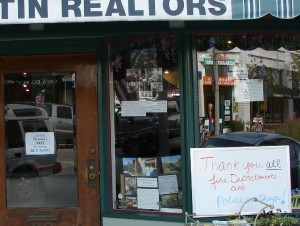 SMNN: What is your most vivid memory of the fire, relating to community reaction to the fire?
SMNN: What is your most vivid memory of the fire, relating to community reaction to the fire?
Elaine: How much the residents cared and were involved – to the point of going out and buying coffee for the first responders.
SMNN: What was your proudest moment during and/or after the fire?
Elaine: Seeing all of the City staff from all the departments coming together to work as a team.
b
b
b
b
City Communication Response to the Fire
Elisa Cox (then known as Elisa Weaver) was the Public Information Officer during the fire, and she and other members of staff that also served as PIO were instrumental in getting the word out through the various media, including SierraMadreNews.Net. I asked her if she’d help with this article, asking questions about communications and her personal recollections, and here’s what I got back:
SMNN: How much better prepared are we to communicate to people during the next fire?
b
b
b
b
b
b
b
b
b
The City was very prepared and commended multiple times for its communication with the residents during the fire. Our greatest changes or enhancements over the past five years include the launch of AM-1630, the City’s Emergency Radio Station, the expansion of the City’s eBlasts notifications, and the explosion of social media – Facebook and Twitter have become excellent sources for extending information quickly.
SMNN: Will press releases be posted on the City website, as well?
Generally, all our press releases are posted on the City website. However, in an emergency like a major wildfire or earthquake, the priority goes to eBlasts, Facebook and Twitter as they are the quickest way of communicating with the public we have at this time. If we cannot post press releases on the website, there is generally a note on the website to visit the City’s Facebook page for the latest information.
SMNN: Are we better prepared to utilize SMTV3 than we were?
We have not greatly updated the technology with SMTV3 since the Santa Anita Fire. The City still utilizes this resource to post slides with emergency information and, (assuming) an emergency does not affect our television infrastructure, we are equipped to air live from the Council Chambers.
SMNN: What is your most vivid memory of the fire, during the fire?
Elisa: I was in my office (on a Saturday) finishing up some paperwork for the Goldberg Park planting we had that morning and stepped outside to check on the Jazz Festival the former Community Arts Commission was hosting, I looked up and saw flames on the mountain. I had the distinct thought, “We’re not going home any time soon.”
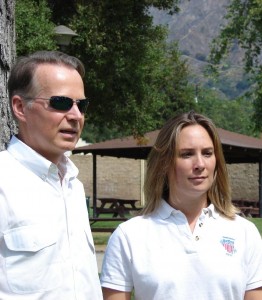
PIO Elisa Weaver (Cox) with then Congressman Dreier addressing press from Sierra Vista Park, Copyright 2008, Bill Coburn
SMNN: What is your most vivid memory of the fire, relating to community reaction to the fire?
Elisa: Everyone was pitching in. Commissioners showed up to see how they could help out; friends-of-friends were helping people they barely, (if at all) knew, pack up and evacuate homes. Lifeguard staff came in on their own to help make sandwiches, and residents all over the place were posting signs of thanks and appreciation. It always amazes me how much we come together as a community in times of trouble.
SMNN: What was your proudest moment during and/or after the fire?
Elisa: After Team 3 took over command of the Fire, Team 3’s PIO Team requested that the City’s PIO team stay in place because we had such a great grass roots communication system set up. The PIO Leader told us that he had not worked with a locality whose information team had been so prepared and effective in reaching the local residents.
Mt. Wilson Trail Race Postponed
The Mt. Wilson Trail Race of 2008 (the 100 year anniversary of the first running of the race) was postponed. It was scheduled for May 24th, and thanks to what Trail Race Chair Pete Siberell described as a “herculean effort” by Charlie Bell, Pete Siberell, Gary Hilliard, John Grace, Pete McNulty, Mark Gage, and Mark Hacker and a crew of volunteers, the race was still going to take place (see our May 17th coverage announcing that the race was on, with photos of the trail just after the fire and the volunteers working on the trail, as well as a detailed accounting of the work that was done and by whom), until a freak May rain storm on the 22nd caused the trail to be, as Siberell describes it “extremely rutted and uneven due to the water running over it and dumping debris everywhere. It was in bad shape and extremely unsafe for both race participants and trail volunteers like Sierra Madre Search & Rescue, the Boy Scouts and Cub Scouts.”
I asked Pete to share his recollections of the fire as regards the Trail Race for this article, and here’s what he had to say… “As I recall it, the MWTR Committee was working hard to get the race ready for Saturday, May 24, as our world was turned upside down with the fire, which pretty much destroyed the one-mile stretch going up the mountain from the trailhead. We recruited a number of crews to work day and night to clear the trail of all the dirt, brush, trees and other detritus that fell on it during the fire. And much of the trail had burning embers still on the trail weeks after the blaze was put out. The trail looked like a
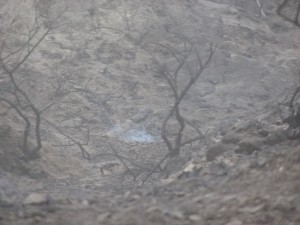
Hard to tell from this angle, but that patch of smoke was probably 3' tall. May 6th, 6 days after the flames were pretty much gone from this area. Copyright 2008, Bill Coburn
deserted, dark moonscape, and all the trail workers would come back off the mountain looking like Pennsylvania miners coming off their shifts.
It was really a herculean effort, and I was so proud of our group of selfless and enthusiastic volunteers (along with Forestry Department staff and even prisoners from the California correctional system!). We would be putting on a Mt. Wilson Trail Race unlike any other, over terrain that would be completely foreign to our runners. But we were ready to go.
And then the rains hit (Editor’s Note: the rain and mudslides hit on the afternoon of May 22nd, see our coverage of the mudslides here). We were expecting some rain and were actually looking forward to it softening up the trail for the race. But not damaging the trail the way it did, essentially cancelling all our hard work. Thankfully, the rain and mudslides did not wash out any sections of the trail. But the trail was extremely rutted and uneven due to the water running over it and dumping debris everywhere. It was in bad shape and extremely unsafe for both race participants and trail volunteers like Sierra Madre Search & Rescue, the Boy Scouts and Cub Scouts.
I remember getting a call from Community Services Department Director Michelle Keith after the hard rain hit, saying we could not run the race on the day it was scheduled – too dangerous, particularly with the chance of more rain and the trail washing out. Clearly, there was no time for even my super volunteers to get the trail ready, but we could postpone the race a week or two, as long as repairs got done. Naturally, I was eager to reschedule it as soon as possible. City staff would not be available to work the next Saturday, but they would two Saturdays later. We settled rescheduling the race for Saturday, June 7, although I was worried we might still not have the manpower or time to get the job done.
But we did. There had to be 40 to 50 men and women who we recruited, working like hell for two weeks to make the trail ready. I remember the city staff doing whatever it could to make sure it had our back. And it did. The job got done!
Runners coming off the mountain the day of the race on June 7, 2008 came back to giant vertical banners hung in Kersting Court, listing every Sierra Madre Volunteer Fire Fighter and thanking each one. All proceeds from the popular post-race beer garden were given to the Santa Anita Fire Fund. Needless to say, it was a most memorable MWTR for everyone, and not just because it was the 100th anniversary. It was because we fought like hell with Mother Nature to put this wonderful community tradition on!”
Public Works Response to Fire and Mud Prevention Follow-up
Bruce Inman, Director of Public Works, also contributed to the article:
SMNN: Which was the bigger challenge for Public Works, the fire or the preparation for mudslides?
Bruce: The fire didn’t present a huge challenge for Public Works; Public Works role in a fire is largely one of assisting with logistics.
SMNN: How much mud was hauled away the following season?
Bruce: Tons and tons, cubic yards and cubic yards, trucks and truck… in other words, a lot. Although we do not have exact numbers, we conservatively have estimated 840 cubic yards or about 100 truckloads.
SMNN: How many homes ended up being evacuated for mud?
Bruce: The City does not have a record of the number of homes evacuated.
SMNN: What was the cost to the City to prepare for mud?
Bruce: The cost to prepare for the mud was over $500,000. Much of that came to the City in the form of a federal grant from USDA/Natural Resources Conservation Service.
SMNN: What issues for Public Works did you see, and how have they been addressed?
Bruce: Public Work’s biggest issue was the limitation on physical access to the mudflow-prone areas of the City, which hampered us in the amount of personnel and equipment we could bring to bear on cleaning up.
SMNN: What is your most vivid memory of the events?
Bruce: My most vivid memory was to be interviewed by a major TV News Network on Christmas Eve 2008 following the issuance of a mandatory evacuation notice for that night. (Editor’s Note: If I remember correctly, steady rain was predicted for Christmas day 2008, but Sierra Madre remained relatively dry all day).
On May 6th, May 10th, 16th and 31st of 2008, I was able to take photos on the Mt. Wilson Trail, even though for some of that time the trail was closed. The trail had burned most of the way to First Water, but there was very little damage along the trail from that point up to Orchard Camp. But up to first water, there was almost complete devastation, with much of the hillside looking more like a moonscape than a hillside on planet Earth. The other day, April 21st, 2013, I took my camera up on the trail with me, with some of the pictures I had taken in May of 2008, that I had emailed to my cell phone, so that I could try to recreate as closely as possible the photos from 2008, giving us a comparison of what the trail looked like then and now. This video shows then and now photos, one right after the other.
As you can see, there has been significant re-growth along the trail, and with what happened in Monrovia last weekend, it’s important that we all be prepared in the event of a repeat of the events of 2008. Cal Fire has just issued a warning about increased fire danger, with incidents up 45% over the average, due to lack of rain.
I’d like to thank City Manager Elaine Aguilar, Director of Human Resources Elisa Cox, Director of Public Works Bruce Inman, Finance Director Karin Schnaider, Mt. Wilson Trail Race Chair Pete Siberell and SMFD Chief Steve Heydorff for their contributions to this article. I’d like to thank all 1055 firefighters from the 30- 35 agencies that responded with assistance during the fire. And I want to say thanks to the residents of Sierra Madre, who responded with love, compassion and spirit to a stressful incident in this City’s history that could have been more stressful had they reacted differently.
To answer the question in the headline, are we ready if it happens again? I think my response is that we won’t know if we are ready as a firefighting entity until we see the magnitude of the fire, but I believe that our fire department and our city staff have done what they can to be ready, and that we as a community have done what we can to be ready, and that’s important. Sure, not everyone in the community has, and I encourage everyone to be diligent in their preparation and to do what they can to be ready. It’s better to be prepared than to try to catch up when it’s too late. But I believe we have a higher percentage of involved and prepared people than most cities can boast. And that’s one of the reasons I believe that as a community, we are ready to face it, even if the next fire proves more destructive, we will be there for each other and face it together. Because that’s the kind of town we are, as we showed in 2008, as we showed after the windstorms of 2011, we are Sierra Madre, and we will help each other through whatever we have to.
In addition to the questions about the Trail Race, I asked Pete Siberell about some of his memories of the fire, and here are his responses…
SMNN: What is your most vivid memory of the fire, during the fire?
Pete: I have three or four vivid memories of the fire. I was running son George to a birthday party in Pasadena on a Saturday, I think, when he pointed out the fire in the hills. I never thought it would be the sole focus of our lives for the next few days. Later in the day, I was at Heasley Field, serving my duty as president of Sierra Madre Little League. My son had a game, I think, and the kids were playing while helicopters were scooping up water out of the settling basins and going back to unload it on the blazes. It was really surreal to see the helicopter veering into the basins while the kids were blithely playing and their parents hoping against hope everything would be OK at home, and the fire looking like it was never going to be put out. (There is a fantastic photo of a helicopter swooping over the field with the kids’ baseball game going on below.)
Later that evening, we watched the fire out the back of our kitchen window, seeing it get closer and waiting for the time we may have to evacuate. Finally, we did end up leaving the house, packing up two cars, two kids and two dogs, and found ourselves in Kersting Court, looking back up Baldwin Avenue and seeing the raging orange fire, realizing….we had not planned on this happening…thinking, what are we going to do now?
SMNN: What is your most vivid memory of the fire, relating to community reaction to the fire?
Pete: Everyone pulled together and helped each other, like you would expect in Sierra Madre. Following up on being stuck with nowhere to go inKersting Court, we ran into Tom Brady, a fellow Sierra Madre Rotary Club member. When he found out we were homeless, or perhaps not interested in leaving town anytime soon, he insisted we stay in his guest house for the night. He and his wife Julie didn’t have to make the offer, but they did.
What are your most vivid memories of the Santa Anita fire? Please feel free to leave a comment below, and share your thoughts and recollections. It is not necessary for you to post a name. However, since I get anywhere from 75 to 200 spam comments a day, I do moderate comments before they get posted. It may be a little while till your comment goes up, especially if it’s posted while I’m at work.

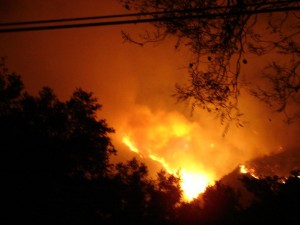
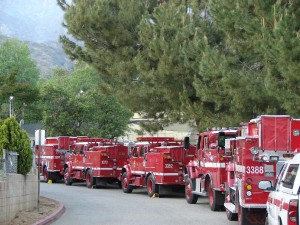
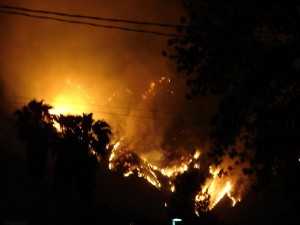
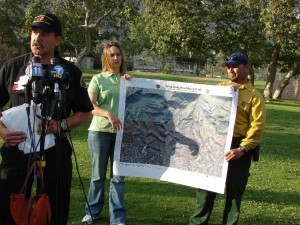
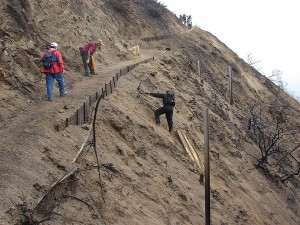
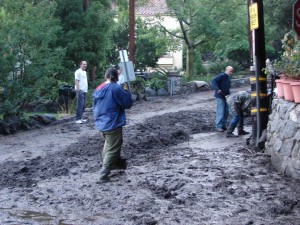
Who was the mayor in 2008? Was it Pete Siberall?
No, as I mentioned in the second paragraph, Kurt Zimmerman was the mayor. I tried to contact Kurt to ask him to participate in this article, left him a voice mail, but didn’t hear back from him. Too bad, I thought he did a great job, especially considering he’d been mayor for less than a week. Would have been interested in his input.